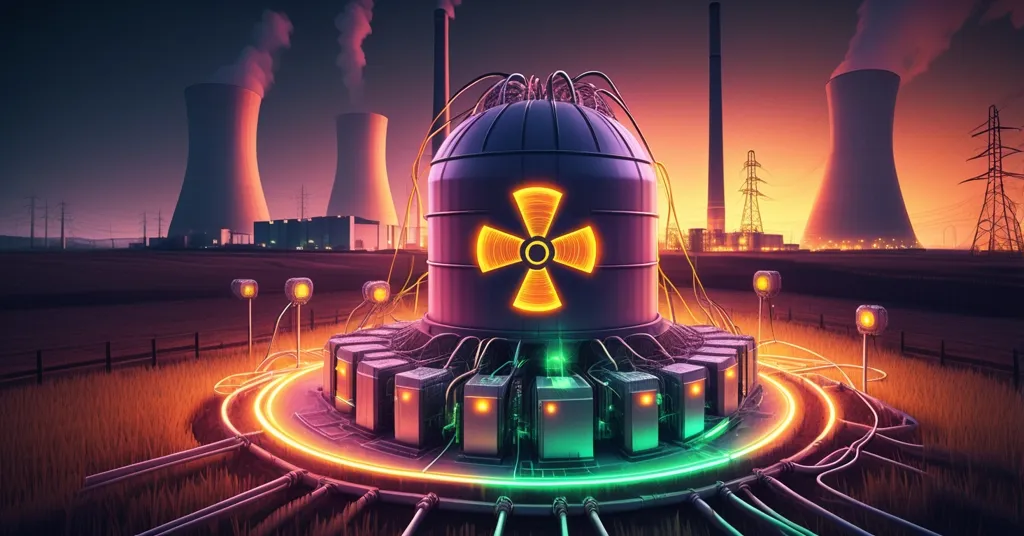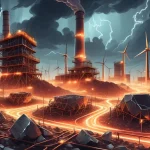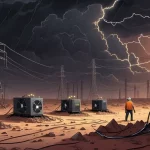Google’s Nuclear Deal with NextEra: A Game-Changer for Bitcoin Mining Energy?

Google’s Nuclear Power Deal with NextEra: A Blueprint for Tech and Bitcoin Mining?
Google has struck a groundbreaking 25-year deal with NextEra Energy to resurrect the Duane Arnold nuclear plant in Iowa, a facility shuttered since 2020, with plans to restart by 2029. This isn’t just a tech giant flexing its muscle—it’s a loud statement about the future of energy for power-hungry sectors like AI, cloud computing, and, yes, Bitcoin mining. As data centers and blockchain networks devour electricity at an unprecedented pace, could nuclear power be the knockout punch we’ve been waiting for?
- Long-Term Pact: Google secures a 25-year deal with NextEra Energy for power from Iowa’s Duane Arnold nuclear plant.
- Plant Revival: The 615-megawatt facility, dormant since 2020, targets a 2029 restart to deliver carbon-free energy.
- Dual Impact: Power will fuel Google’s data centers and support local Iowa communities via the Central Iowa Power Cooperative.
Google’s Big Bet on Nuclear: Why Now?
The Duane Arnold nuclear plant, once a steady producer of 615 megawatts, was sidelined in 2020 after economic struggles and a devastating storm wrecked its infrastructure. Under this new agreement, NextEra Energy takes full ownership, buying out local partners like the Central Iowa Power Cooperative (CIPCO) and Corn Belt Power Cooperative. By 2029, the plant is expected to hum back to life, pumping out carbon-free energy—power that doesn’t spew greenhouse gases like carbon dioxide into the atmosphere, a key driver of climate change. The bulk of this output will feed Google’s local offices and data centers, the insatiable engines behind AI models, cloud services, and our endless digital habits. A smaller portion will go to CIPCO, ensuring some of that clean energy benefits Iowa’s local grid. For more on this landmark agreement, check out the details of Google’s 25-year partnership with NextEra Energy.
Why nuclear, though? Data centers are like the ultimate night owls—they never sleep, demanding electricity 24/7. Renewables like solar and wind, while noble, are fickle friends; the sun dips out after dark, and the wind takes unscheduled breaks. Nuclear power, the grizzled veteran of energy sources, doesn’t flinch. It’s a steady beast, churning out power regardless of weather or time, and with modern safety tech, it’s shed much of the boogeyman aura from past disasters. For Google, this deal isn’t just about keeping servers cool—it’s a lifeline to meet the explosive energy demands of artificial intelligence and cloud computing, sectors burning through power faster than a meme coin pumps on Twitter.
As Sophie Karp, an analyst at KeyBanc Capital Markets, pointed out:
“The speed at which this deal was set up highlights the high demand for zero-emission and reliable power.”
She’s dead-on. This move isn’t happening in a vacuum. The U.S. is seeing a nuclear renaissance, with other mothballed plants getting a second shot. Constellation Energy plans to restart a reactor at Three Mile Island in Pennsylvania by 2027—yes, the same site tied to the 1979 meltdown, now under tighter safety protocols. Holtec International is pushing to reopen the Palisades plant in Michigan by 2025, and in South Carolina, Santee Cooper and Brookfield Asset Management are hashing out plans to finish the VC Summer project, abandoned in 2017 after billions in losses. Nuclear isn’t just creeping back; it’s being hauled into the ring by raw necessity.
Energy Hunger: From Data Centers to Bitcoin Mining
Let’s zoom in on why this matters beyond Silicon Valley. Bitcoin mining, the backbone of the world’s leading cryptocurrency, is an energy hog to rival any data center. Miners run specialized hardware—think industrial-grade number-crunchers—nonstop to validate transactions and secure the network, consuming an estimated 0.1-0.2% of global electricity annually. That’s roughly the juice of a small country, and it’s only growing as Bitcoin’s hash rate climbs. Like Google’s servers, mining rigs can’t afford downtime; a flaky power source means lost revenue and weakened network security.
Historically, miners have chased cheap, often renewable-heavy grids or tapped into stranded energy—think hydroelectric in rural China or flared gas in oil fields. But reliability remains a nagging issue. Solar and wind can’t guarantee uptime, and hydropower dries up in droughts. Nuclear power, with its near-constant output, could be the dark horse Bitcoin miners didn’t know they needed. A stable, carbon-free supply might not just cut costs long-term but also polish crypto’s often-criticized environmental footprint. For Bitcoin maximalists, who see the network as the ultimate decentralized fortress, a robust energy backbone like this could cement its dominance over altcoins scrambling for scraps.
Yet, altcoin ecosystems and other blockchain projects—think Ethereum’s staking nodes or experimental layer-2 solutions—also stand to gain, albeit differently. These setups often prioritize flexibility over raw power, running on lighter infrastructure. Nuclear’s hefty upfront costs and regulatory red tape might price out smaller players, creating another wedge where Bitcoin’s deep-pocketed mining operations could pull ahead. Still, if nuclear tech scales down (more on that soon), even niche chains might find a seat at the table.
Modular Reactors: A Glimpse of Tomorrow’s Grid?
Google and NextEra aren’t playing checkers—they’re chess masters looking ten moves ahead. Beyond reviving Duane Arnold, they’re already partners on 3 gigawatts of clean energy projects across the U.S., and their sights are set on cutting-edge solutions like modular reactors. Unlike the hulking nuclear plants of yesteryear, these are smaller, more nimble units designed to be built faster and deployed closer to where power’s needed—think near a data center in Nevada or a mining farm in Texas. They’re like the smartphone of nuclear tech: compact, adaptable, and theoretically game-changing.
For blockchain networks, this could be huge. Miners and node operators often spread out geographically to avoid centralization risks. Modular reactors, if they pan out, could dot the landscape, offering localized power without the baggage of massive grid dependency. Imagine a Bitcoin mining hub in the Midwest, powered by a nearby modular unit, fully off the traditional utility teat—decentralization in action. But let’s pump the brakes: this tech is still largely untested at scale. Pilot projects exist, yet timelines stretch into the 2030s, and costs remain murky. It’s a shiny idea, but not yet a bankable one.
The Flip Side: Nuclear’s Not All Sunshine
Before we start chanting “nuclear to the moon,” let’s keep it real. Restarting plants like Duane Arnold isn’t a weekend DIY project. We’re talking billions in upfront costs to refurbish aging infrastructure, navigate a labyrinth of regulatory approvals, and convince a public still spooked by names like Fukushima and Chernobyl that this time, it’s different. Modern safety standards are leaps ahead of the 1970s, sure, but one slip-up could tank the industry’s comeback faster than a rug pull on a shitcoin.
Then there’s the waste. Nuclear power might dodge carbon emissions, but it leaves behind radioactive leftovers that stick around longer than a bad NFT investment—thousands of years, to be exact. Storage solutions like deep geological repositories exist, but no country’s nailed a perfect, permanent fix. For a crypto community obsessed with sustainability narratives (especially post-Ethereum’s energy-sipping Merge), this is a glaring asterisk. And while Google’s deep pockets can absorb these risks, smaller players in the blockchain space might balk at hitching their wagon to a tech with such baggage.
Another thorn: centralization. NextEra’s full ownership of Duane Arnold means one corporation controls the keys to this power kingdom. For crypto purists championing freedom from centralized chokeholds, partnering with energy giants could feel like trading one master for another. Could nuclear deals bind Bitcoin to the very regulatory systems it was born to disrupt? It’s a question worth chewing on.
A Nuclear Future for Tech and Crypto: Boom or Bust?
This Google-NextEra deal is more than a corporate handshake—it’s a window into how tech-driven economies might power up in the coming decades. Nuclear’s revival, fueled by desperate energy needs and decarbonization targets, could rewrite the rules for infrastructure and policy. For Bitcoin and blockchain networks, it dangles a tantalizing promise: reliable, long-term energy to fuel decentralization without choking the planet. Miners could stabilize operations, cut carbon critiques, and maybe even thrive off-grid if modular tech delivers.
But don’t bet the farm just yet. High costs, public skepticism, and unresolved waste issues loom large. And let’s not ignore the irony—if nuclear partnerships mean cozying up to corporate or government oversight, crypto’s anti-establishment soul might take a hit. Still, as energy demands skyrocket for both AI and mining, solutions like this aren’t just nice-to-haves; they’re do-or-die. Google’s rolled the dice. Will Bitcoin miners be next to ante up?
Key Questions and Takeaways on Nuclear Power and Crypto
- What’s pushing Google toward nuclear energy, and could Bitcoin miners follow suit?
Google’s chasing 24/7 power for AI and data centers, a need mirroring Bitcoin mining’s relentless energy hunger; miners could tap nuclear for stable, carbon-free power to boost operations and green creds. - Is nuclear energy a true fix for tech and crypto’s power woes?
It’s a heavyweight contender with constant output and zero emissions, but sky-high costs, waste headaches, and safety fears mean it’s only part of the energy puzzle for tech and blockchain. - How does this deal touch local communities and decentralization goals?
Iowa locals score some clean power via CIPCO, but NextEra’s centralized control clashes with crypto’s push for distributed, independent systems—a tension to watch. - Could modular reactors reshape blockchain infrastructure?
Their compact design might power scattered mining hubs or nodes off-grid, but unproven tech and long timelines make them a speculative play for now. - Does nuclear’s comeback vibe with crypto’s ethos of freedom and disruption?
It shakes up fossil fuel norms and hints at energy autonomy, aligning with crypto’s rebel streak, yet regulatory baggage and corporate dominance could sour the match. - Are nuclear partnerships a centralization risk for Bitcoin’s network?
Tying to big energy players like NextEra might anchor miners to centralized grids or oversight, a potential betrayal of Bitcoin’s decentralized heart.



